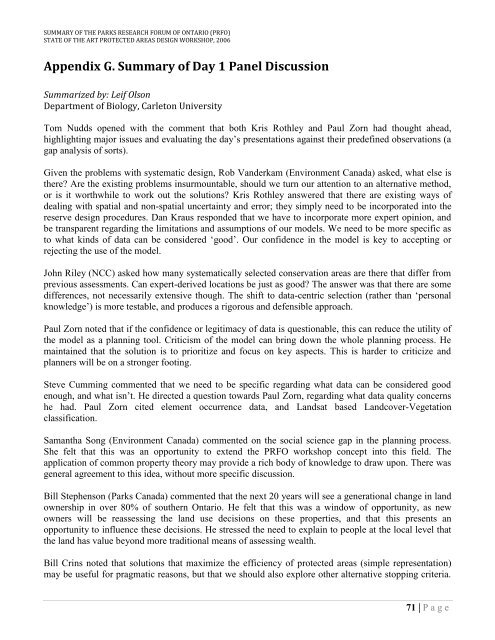Top-Down vs. Bottom Up: Working Towards Consensus ... - CASIOPA
Top-Down vs. Bottom Up: Working Towards Consensus ... - CASIOPA
Top-Down vs. Bottom Up: Working Towards Consensus ... - CASIOPA
- No tags were found...
Create successful ePaper yourself
Turn your PDF publications into a flip-book with our unique Google optimized e-Paper software.
SUMMARY OF THE PARKS RESEARCH FORUM OF ONTARIO (PRFO)STATE OF THE ART PROTECTED AREAS DESIGN WORKSHOP, 2006Appendix G. Summary of Day 1 Panel DiscussionSummarized by: Leif OlsonDepartment of Biology, Carleton UniversityTom Nudds opened with the comment that both Kris Rothley and Paul Zorn had thought ahead,highlighting major issues and evaluating the day‟s presentations against their predefined observations (agap analysis of sorts).Given the problems with systematic design, Rob Vanderkam (Environment Canada) asked, what else isthere? Are the existing problems insurmountable, should we turn our attention to an alternative method,or is it worthwhile to work out the solutions? Kris Rothley answered that there are existing ways ofdealing with spatial and non-spatial uncertainty and error; they simply need to be incorporated into thereserve design procedures. Dan Kraus responded that we have to incorporate more expert opinion, andbe transparent regarding the limitations and assumptions of our models. We need to be more specific asto what kinds of data can be considered „good‟. Our confidence in the model is key to accepting orrejecting the use of the model.John Riley (NCC) asked how many systematically selected conservation areas are there that differ fromprevious assessments. Can expert-derived locations be just as good? The answer was that there are somedifferences, not necessarily extensive though. The shift to data-centric selection (rather than „personalknowledge‟) is more testable, and produces a rigorous and defensible approach.Paul Zorn noted that if the confidence or legitimacy of data is questionable, this can reduce the utility ofthe model as a planning tool. Criticism of the model can bring down the whole planning process. Hemaintained that the solution is to prioritize and focus on key aspects. This is harder to criticize andplanners will be on a stronger footing.Steve Cumming commented that we need to be specific regarding what data can be considered goodenough, and what isn‟t. He directed a question towards Paul Zorn, regarding what data quality concernshe had. Paul Zorn cited element occurrence data, and Landsat based Landcover-Vegetationclassification.Samantha Song (Environment Canada) commented on the social science gap in the planning process.She felt that this was an opportunity to extend the PRFO workshop concept into this field. Theapplication of common property theory may provide a rich body of knowledge to draw upon. There wasgeneral agreement to this idea, without more specific discussion.Bill Stephenson (Parks Canada) commented that the next 20 years will see a generational change in landownership in over 80% of southern Ontario. He felt that this was a window of opportunity, as newowners will be reassessing the land use decisions on these properties, and that this presents anopportunity to influence these decisions. He stressed the need to explain to people at the local level thatthe land has value beyond more traditional means of assessing wealth.Bill Crins noted that solutions that maximize the efficiency of protected areas (simple representation)may be useful for pragmatic reasons, but that we should also explore other alternative stopping criteria.71 | P a g e


